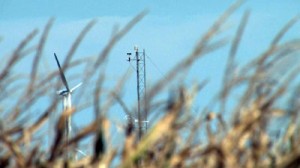DOE researcher suggests agricultural benefits from wind turbines

This one is bound to create some controversy, given all the negative things I have read about living with or near wind turbines: Researchers at the U.S. Department of Energy's Ames Laboratory have published some preliminary research suggesting that wind turbines might have agricultural benefits for corn and soybean crops, keeping them cooler and dryer and potentially fending of certain fungal infections.
Hmmm.
The research was presented at a meeting of the American Geophysical Union in San Francisco by Gene Takle, an Ames Laboratory researchers and agricultural metereology expert. Here's what he has to say in a press release (the video amplifies his comments): "We've finished the first phase of our research, and we're confident that wind turbines do produce measurable effects on the microclimate near crops."
Although Takle and his fellow researcher are quick to point out that this is only early data and much more researcher needs to be done, one example of how a turbine might help is by making crops more resilient to excess heat or early frosts. For example, the turbines can stir that air on cold nights, keeping night-time temperatures around crops warmer. The turbines could also help prevent excess moisture from dew, by helping it evaporate. This could help protect against moisture-caused fungus, the researchers note.
Says Takle: "In a simplistic sense, a wind turbine is nothing more than a tall tree with a well-pruned stem. For a starting point for this research, we adapted a computational fluid model that we use to understand trees. But we plan to develop a new model specific to wind turbines as we gather more data."
Definitely research worth following. By the way, this research was funded by the royalty income generated from the Ames Laboratory seed funding program and also by money from the DOE's Office of Energy Efficiency and Renewable Energy.
